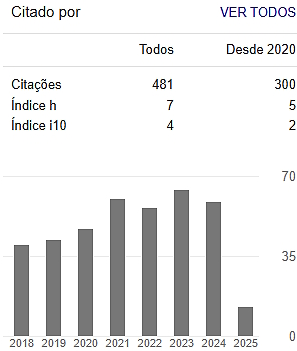RECONHECIMENTO DE FALHAS ESTRUTURAIS UTILIZANDO SISTEMA IMUNOLOGICO ARTIFICIAL WAVELET
Palavras-chave:
Sistemas Imunológicos Artificiais, Transformada Wavelet, Rotores DinâmicosResumo
Este trabalho apresenta uma metodologia inteligente para o monitoramento da integridade estrutural de um rotor dinâmico, o sistema imunológico artificial Wavelet. A combinação do sistema imunológico artificial com a transformada de Wavelet gera uma ferramenta inovadora para realizar a identificação, localização e classificação de falhas estruturais. Através desta metodologia, os projetos de máquinas industriais são desenvolvidos para atender essas necessidades, reduzindo as falhas e antecipando os erros encontrados em máquinas operantes. Uma _área emergente de projetos de máquinas são as máquinas rotativas também denominadas de rotores dinâmicos, sendo estes, aplicados a turbinas de aviões, turbinas a vapor para a produção de energia elétrica, turbo compressores, entre outros. Para validar esta metodologia dados experimentais são coletados, e a partir deste, gerados diversos situações (condição normal e condições em falhas), obtendo-se uma base de dados de sinais, que foram analisados pelo método proposto. Os resultados obtidos pelo Sistema Imunológico Artificial Wavelet apresentam eficiência e robustez.
Downloads
Referências
BURDZIK, R.; KONIECZNY, Ł.; FOLEGA, P., 2014, Structural Health Monitoring of Rotating Machines in Manufacturing Processes by Vibration Methods, Advanced Materials Research, v.1036(1), p. 642–647, 2014. Disponível em: <http://dx.doi.org/10.4028/www.scientific.net/amr.1036.642>. Acesso: 25 junho 2020. https://doi.org/10.4028/www.scientific.net/AMR.1036.642
DAUBECHIES, I. Ten Lectures on Wavelets. Philadelphia: Society for Industrial and Applied Mathematics, n.61, 1992. https://doi.org/10.1137/1.9781611970104
DERAEMAEKER, A.; WORDEN, K., New Trends in Vibration Based Structural Health Monitoring. New York: SpringerWien, 2010. https://doi.org/10.1007/978-3-7091-0399-9
FARRAR, C.R.; WORDEN, K., Structural Health Monitoring: A Machine Learning Perspective. Chichester: John Wiley, 2013. https://doi.org/10.1002/9781118443118
FORREST, S.A.; PERELSON, A.L.; CHERUKURI, R., Self-nonself discrimination in a computer. In: Proceedings of the IEEE Symposium on Research in Security and Privacy. Oakland: IEEE, 1994, p. 202-212.
GOPALAKRISHNAN, S.; RUZZENE, M.; HANAGUD, S., Computational Techniques for Structural Health Monitoring. London: Springer-Verlag, 2011, p. 517. https://doi.org/10.1007/978-0-85729-284-1
LIMA, F. P. A.; CHAVARETTE, F. R.; SOUZA, S. S. F.; LOPES, M. L. M. Monitoring and Fault Identification in Aeronautical Structures Using an Wavelet-Artificial Immune System Algorithm. In: Stephen Ekwaro-Osire, Aparecido C. Gonçalves, Fisseha M. Alemayehu. (Org.). Probabilistic Prognostics and Health Management of Energy Systems. 12 ed. São Paulo: Springer International Publishing AG, Chaim, 1, 2017, p. 1-17.
MALLAT, S., A Wavelet tour of signal processing, New York: Academic Press., 1999. https://doi.org/10.1016/B978-012466606-1/50008-8
MORO, T.C.; CHAVARETTE, F.R., ROEFERO, L.G.P., OUTA, R. Detecão de falhas estruturais de um prédio de dois andares utilizando Sistema Imunológico Artificial. Colloquium Exactarum, v. 11, p. 73-84, 2019. Disponível em: <http://dx.doi.org/10.5747/ce.2019.v11.n4.e298>. Acesso: 25 junho 2020. https://doi.org/10.5747/ce.2019.v11.n4.e298
TINGA, T.; LOENDERSLOOT, Aligning PHM, SHM and CBM by Understanding the Physical System Failure Behaviour, In: Proceedings of the European Conference of the Prognostics and Health Management Society, v. 2(1), 2014, p. 162-171.

